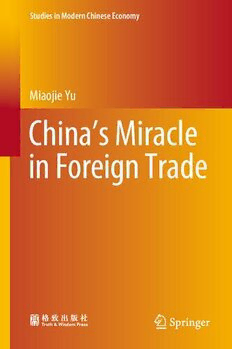Table Of ContentStudies in Modern Chinese Economy
Miaojie Yu
China’s Miracle
in Foreign Trade
Studies in Modern Chinese Economy
The series aims to look through all key issues around China’s development since
thereformandopen-up,involvingtopicsofeconomicgrowth,institutionalreform,
reform of state-owned enterprises, income distribution and balanced development,
movementofpopulationandregionaleconomicdevelopment,ruraleconomicdevel-
opment, innovation and economic incentive polices and local governance etc. The
authorsareallfirst-classeconomistsinChina.It’shelpfultounderstandthehistory
aswellasthestatusquoofChina’spathindevelopment.
Moreinformationaboutthisseriesathttps://link.springer.com/bookseries/16588
Miaojie Yu
China’s Miracle in Foreign
Trade
MiaojieYu
NationalSchoolofDevelopment
PekingUniversity
Beijing,China
ISSN2730-5376 ISSN2730-5384 (electronic)
StudiesinModernChineseEconomy
ISBN978-981-16-6029-0 ISBN978-981-16-6030-6 (eBook)
https://doi.org/10.1007/978-981-16-6030-6
JointlypublishedwithTruthandWisdomPress
TheprinteditionisnotforsaleinChina(Mainland).CustomersfromChina(Mainland)pleaseorderthe
printbookfrom:TruthandWisdomPress.
ISBNoftheCo-Publisher’sedition:978-7-5432-2946-4
©TruthandWisdomPress2022
Thisworkissubjecttocopyright.AllrightsarereservedbythePublishers,whetherthewholeorpartofthe
materialisconcerned,specificallytherightsofreprinting,reuseofillustrations,recitation,broadcasting,
reproductiononmicrofilmsorinanyotherphysicalway,andtransmissionorinformationstorageand
retrieval,electronicadaptation,computersoftware,orbysimilarordissimilarmethodologynowknown
orhereafterdeveloped.
Theuseofgeneraldescriptivenames,registerednames,trademarks,servicemarks,etc.inthispublication
doesnotimply,evenintheabsenceofaspecificstatement,thatsuchnamesareexemptfromtherelevant
protectivelawsandregulationsandthereforefreeforgeneraluse.
Thepublishers,theauthors,andtheeditorsaresafetoassumethattheadviceandinformationinthisbook
arebelievedtobetrueandaccurateatthedateofpublication.Neitherthepublishersnortheauthorsor
theeditorsgiveawarranty,expressorimplied,withrespecttothematerialcontainedhereinorforany
errorsoromissionsthatmayhavebeenmade.Thepublishersremainneutralwithregardtojurisdictional
claimsinpublishedmapsandinstitutionalaffiliations.
ThisSpringerimprintispublishedbytheregisteredcompanySpringerNatureSingaporePteLtd.
The registered company address is: 152 Beach Road, #21-01/04 Gateway East, Singapore 189721,
Singapore
Dedicatedtomydarling,WeiTian
&myson,YushenYu
Preface
China began its era of reform and opening-up around four decades ago, which
profoundly changed China and has significantly influenced the world. As a result
of its opening-up policies, China has become the largest country in the world in
goodstradeandthesecond-largestcountryinservicestrade,registeringwithgoods
tradeofUSD4.58trillionandservicestradeofUSD784billionin2019.Partially
becauseofthisamazingachievement,thegrowthofChina’sforeigntradesince1979
isdescribedas“China’sMiracleofForeignTrade.”
HowChinarealizethissplendidachievementwithinsuchashorttime?Thisisa
verynaturalquestionthatcomestoourmind.Chapter1henceprovidesapossible
answer to this question. Briefly, China’s opening-up since 1979 has experienced
threestages:theextensivemargin,theintensivemargin,andall-aroundopening-up.
Before China’s access to the World Trade Organization (WTO) in 2001, China’s
foreigntradeexhibitsafeatureofarapidexpansionintheextensivemarginwhich
isdue,inlargepart,toChina’slowlabourcostbasedonitslabourabundantfactor
endowment. It is important to stress processing trade, especially in this stage, that
plays an important role to contribute China’s miracle of international trade. After
China’saccessiontotheWTO,thedevelopmentofChina’sforeigntradeisfeatured
withthedeepeningintensivemargin.ThemaindrivingforceofChina’sincremental
internationaltradebecametherealizationofscaleeconomieswiththelargeinterna-
tionalmarket.Afterglobalfinancialcrisisin2008,becauseofincreasinglabourcosts
andanexpandingChina’sdomesticmarket,weakforeigndemandandtradeprotec-
tionism in some developed countries, and cheap labour costs in other developing
countries,theChinesegovernmenthasproposedanall-aroundopening-upasthenext
majorphase,especiallysince2013.ThenewdrivingforceofChina’sinternational
trade will be the dividends of institutional reform achieved by expanding imports,
expanding market access for foreign firms, strengthening IP rights protection, and
nurturinginnovation.
TurningtothedevelopmentstrategyofChina’sforeigntrade,itisevidenttosee
thatChinastartedwiththeadoptionofimportsubstitutionaftergainingitspolitical
independencein1949.Chapter2aimstounderstandhowimportsubstitution,along
withotherpolicyinstruments,helpedChinatoestablishitsowncompleteindustrial
vii
viii Preface
system. Particularly, Chap. 2 extends the Sah-Stiglitz “Economics of Price Scis-
sor”modelbyextendingtheirmodeltoanopeneconomyandallowingagricultural
rationingandestimateitskeystructuralparametersinChina’sgovernmentwelfare
objectivefunctionusingaprovince-levelpaneldatabeforeChina’seconomicreform.
Itturnsoutthattheweightofpeasantsinthegovernment’swelfareobjectivefunction
issmallerthantheweightofworkers.Inaddition,theweightofcurrentconsumption
isalsosmallerthanthatoffutureinvestment.Suchfindingswereconsistentwiththe
realityofChineseeconomybeforetheeraofeconomicreform.
Chapter 3 takes a step forward to consider how import protection affects an
importing sector’s relative size. This is an important question indeed for both
academic researchers and policymakers. Trade theory has no clear prediction on
howimportprotectionaffectsanimportingsector’srelativesize.Itisalsoimportant
forpolicymakerstounderstandtheeffectivenessofindustrialprotection.InChap.3
we estimate the impact of trade protection on industrial production relative size
basedonatranslogGDPfunctionalsystem.Usinganindustrialpaneldatasetand
controllingforfactorendowmentsandtechnologyimprovement,wefindempirical
evidence that trade protection does not help much increase asector’s relative size.
Suchfindingsarealsorobusttoboththeinclusionoftheroleofpoliticaleconomy
andthecoverageofvariousnon-tariffmeasuresasproxiesofindustrialprotection.
Export-led development strategy is one of the most important driving forces to
boostChina’sforeigntrade,particularly,inthelastthreedecadesinthe20thcentury.
The key interesting questions are how China proceeds its export-led development
strategy, and consequently, how such policy designs affect firm productivity given
that manufacturing firms are the most fundamental microeconomic individual to
support the whole-country’s macroeconomic development. Section 3 picks up this
taskandcoversfourchaptersfromChaps.4to7provideananswertothisimportant
question.
Chapter4startswithafirm-levelinvestigationonChina’sprocessingtrade,with
a particular focus on size, trends, characteristics, and key features. We begin to
analyze why processing trade has developed rapidly in China since 1979. China’s
opening-uppolicy,particularlytheestablishmentofspecialexportzones,hasplayed
a significant role in the rapid growth of processing trade. We use transaction-level
tradedata(2000–2006)fromChinatoinvestigatevariousfactorsaffectingprocessing
trade. These include origin and destination countries, leading import and export
commodities,transportmodes,firmownership,leadingportsandtheirtradevolume,
andtopcitiesandprovinceswhereproducersandconsumersarelocated.
SinceChina’sopening-up,Chinahasbecometheworldfactory.Needlesstosay,
itisessentialtounderstandChinesemanufacturingfirms’productivityifonewants
tounderstandtheChineseeconomy.Yethowproductivityisandshouldbeestimated
remainsanareaofactiveresearch.Chapter5reviewssomestate-of-the-artmethods
forestimatingproductivity.WeapplythesemethodstoChinesemanufacturingdatain
thenewcentury.Weestimatedozensofdifferentspecificationsforhundredsproduc-
tionfunctionestimatesandcomparethestrengthsandpitfallsofeachTotalFactor
Productivity(TFP)estimationapproach.
Preface ix
SinceChina’sopening-upinlate1970s,Chinasetupavarietyofindustrialparks
including Special Economic Zones (SEZs), economic development zones, export
processing zones, and high-tech industrial zones. How does the establishment of
industrial zones affect firm productivity? Chap. 6 provides an analysis for us to
enrich the understanding of this question. In Chap. 6, we investigate the effect of
theplace-basedindustrialpolicyonfirmproductivityinChinausingtheresponses
ofChinese medium and largefirms totheestablishment ofstate-level SEZs inthe
firstdecadeofthenewcentury.EvidenceshowsthatSEZsimproveproductivityand
generatepositivespillovers.Theproductivitypremiumoffirmslocatedinindustrial
parksismainlyattributedtothebetterbusinessenvironment(lowertaxes)inSEZs.
Onaverage,theestablishmentofaSEZleadstoaproductivitygainof19%.
Chapter7takesastepfurthertoexaminehowfirmsadjusttheirextensivemargin
measured by firm’s export scope in response to trade liberalization. Chapter 7
providesatheoreticalandempiricalanalysisoftheeffectsofmarketcompetitionand
marketexpansiononfirms’productlinedecisions.Thetheoreticalmodelexplicitly
incorporatescostofmanagement.Firmsareheterogeneousintermsofmanagerial
efficiency.Weuseimporttariffcutasaproxyforincreasedmarketcompetitionand
export tariff reduction as a proxy for market expansion. The theoretical analysis
predicts that the home country’s tariff cut reduces all home firms’ export product
line,whereasinresponsetotheforeigncountry’stariffreductions,firmswithhigh
managerialefficiencyexpandexportproductlineswhereasfirmwithlowmanagerial
efficiencyreducesexportproductlines.ThesepredictionsaresupportedbyChinese
firm-leveldata.
Since 1990s, China experiences a rapid trade liberalization by cutting import
tariffs.SuchpolicyreformshavesignificantimpactonChineseeconomy.ThusSect.4
includestwochapters(i.e.,Chaps.8and9)toexaminehowtradeliberalizationaffects
Chinesefirmproductivity.
Chapter8developedaMincer(1974)-typeapproachtoinvestigatetheimpactof
input trade liberalization on firms’ wage inequality between skilled and unskilled
workers(orskillpremium).Whencontrollingforproductmarkettariffsinafirm’s
industry, we find robust evidence that reduced input tariffs in a firm’s industry
are associated with a higher skill premium at firms with more skilled workforces.
Thiseffectismorepronouncedatordinary(non-processing)firms.Wealsoprovide
evidence that reduced input tariffs in a firm’s industry are associated with higher
valueaddedandprofitsatfirmswithmoreskilledworkforces.
Chapter9insteadexamineshowinputliberalizationaffectsfirmimportbehaviour.
ByusingcomprehensiveproductionandtradedataofChinesefirms,weshowthat
import sources of Chinese firms switch from developing countries to developed
countries as input tariffs fall in China. This is evident for both import value and
import scope. The observation still exists after we exclude the possible influence
of reducing processing trade. We further demonstrate that the mechanism can be
attributedtoqualityupgradingandinnovationledbyinputcostreductions.Wealso
carefully handle the possible endogeneity problem and the findings are robust and
significanttodifferentempiricalmethodologiesandmeasurements.
x Preface
The last section of the present book examines the impact of China’s ongoing
all-aroundtradeliberalization.ItincludesthreechaptersfromChaps.10to12.
As Prof. Paul Krugman mentioned: productivity is not everything, but in the
longrunitisalmosteverything.Wehavealreadyseen,mostlyinSect.2,thatfirm
productivity plays a key role for us to understand Chinese economy. But an un-
answeredquestioniswhatdeterminesfirmproductivity.Chapter10tendstopickup
thisquestionfromtheperspectiveoffirmtraining.
Particularly, Chap. 10 discusses a novel mechanism—worker training—that
outputtradeliberalizationaffectsfirmproductivity.WithdisaggregatedChinesefirm-
levelproductiondatafrom2004to2006,wefindstrongevidencethatoutputtrade
liberalizationboostfirmproductivity.Moreimportantly,aftercontrollingforfirm’s
self-selectiontoinvestonworkertraining,ourextensiveempiricalsearchsuggests
the following findings. First, with fierier import competition, firms experience a
decreaseinprofitabilityandhencearelesslikelytoinvestonfirmtraining.Second,
lowerproductivefirmsaremorelikelytotraintheirworkers,asotherwisetheywould
collapseandexitfromthemarket.Thelowerthefirmproductivity,themoreisthe
firm’sworkertrainingexpenses.Finally,theeffectofoutputtradeliberalizationon
firmproductivityismorepronouncedforfirmswithmoretraininginvestment.
Sincethe2008globalfinancialcrisis,therehasbeenanewwaveoftradeprotec-
tionism headed by the USA, casting a shadow on the world economy. With slug-
gishexternaldemandandincreasingtradeprotectionismbytheUSAandtheEuro-
peanUnion,Chinaisfacingseverechallengesinimplementingitsdeeper,ongoing
reforms.Chapter11introducessuchreformsindetail.Torespondactivelytosuch
challenges, the Communist Party of China’s 19th National Congress proposed to
“promote a new pattern of all-round opening up.” In particular, the establishment
of free trade ports is considered an important means to realize deeper integration
withtheworldeconomy.Thispaperdiscussesthebackground,themotivation,the
possiblechallengesaswellasafeasiblepathforthesuccessfulimplementationof
freetradeportsinChina.Basedontheinternationalexperience,theconstructionof
free trade ports in China requires freer trade in goods, high mobility of talent and
freecapitalflow.Finally,Chap.12providesabriefsummaryofChina’sopening-up
experienceinthelastfourdecades.
My last remark is to express my sincere gratitude to all my co-authors who
contributedtoeachchapterofthebook,includingProfs.BoChen,JustinLin,Qing
Liu,LarryQiu,WeiTian,andZhihao.Thesameappreciationextendstomyformer
studentsincludingXiaominCui,WeiXiang,ZhuxiXu,andHuihuangZhu.Without
theirwarmsupportandintellectualcontributions,itisimpossibletohavethisvolume.
I also want to thank Dr. Chuangyin Xu to provide excellent research assistance to
thebook.IoweMs.YunyuChen,mycolleagueintheGezhiPress,toencourageme
towriteupthisbook.Ofcourse,allerrorsaremine.

